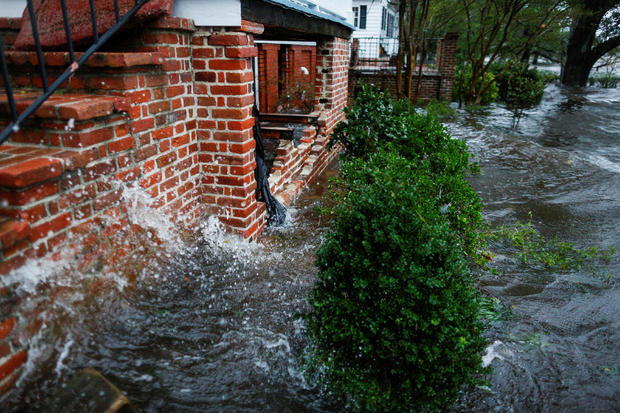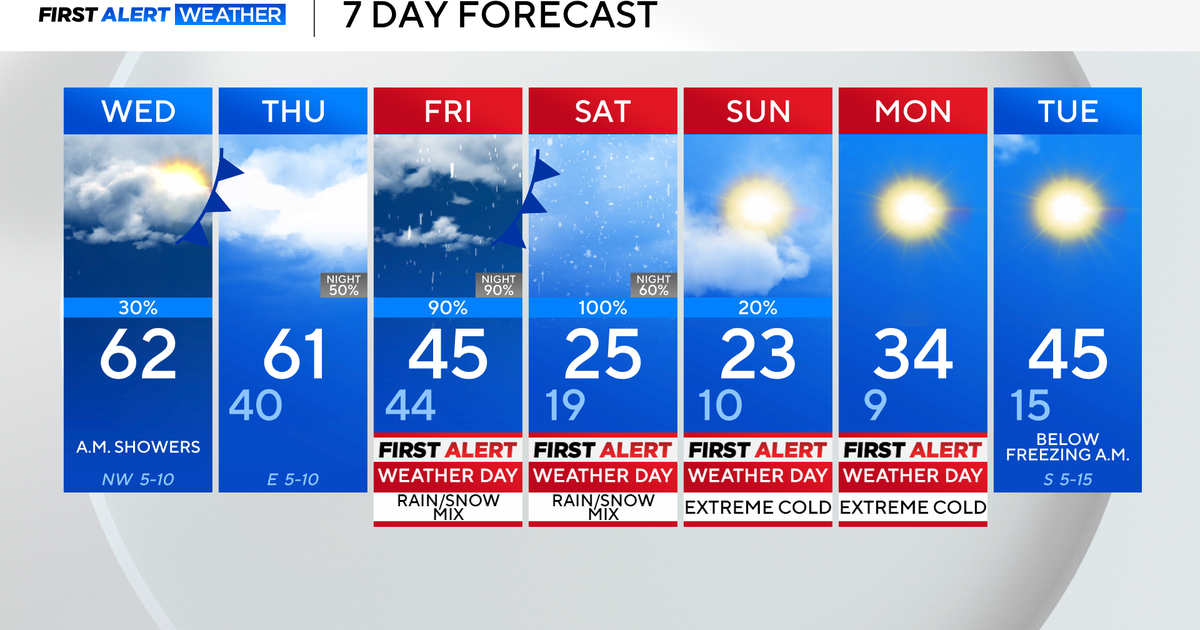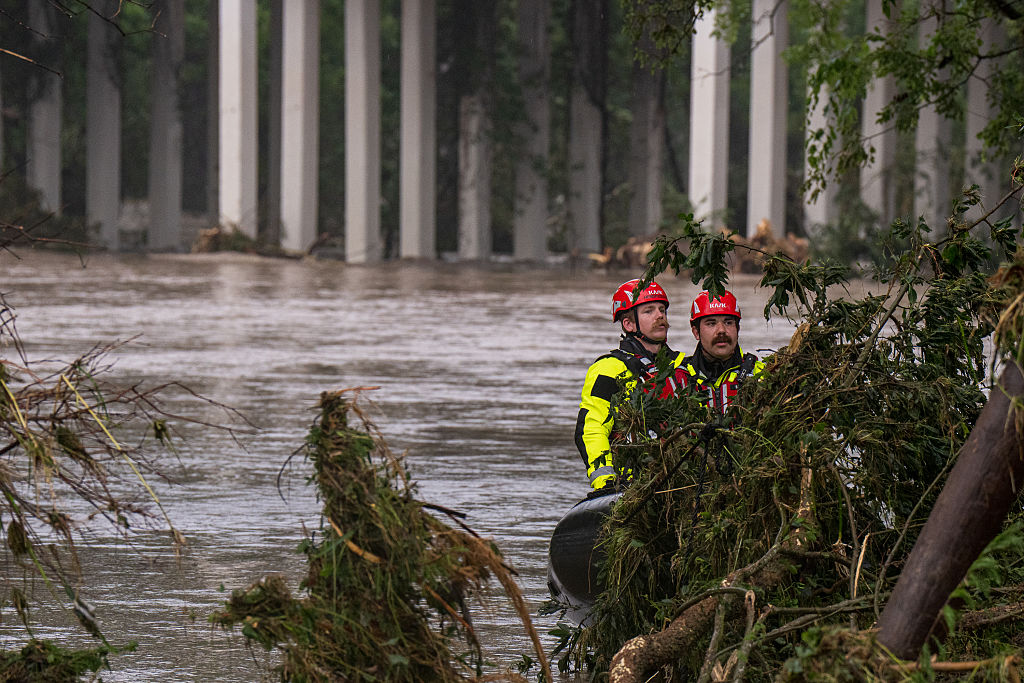Florence: Tropical Storm besieges North and South Carolina
Florence fast facts:
- Tropical Storm Florence is "crawling" across South Carolina and causing "catastrophic flooding" in North and South Carolina, National Hurricane Center says
- Some towns have received more than 2 feet of rain and forecasters warned that rains totaling up to 3.5 feet could trigger epic flooding well inland through early next week
- At 11 a.m. Saturday, the center of the storm was about 40 miles west of Myrtle Beach, South Carolina, moving west at 2 mph
- Maximum sustained winds are 45 mph
- 5 people are confirmed dead from storm-related incidents
- Storm knocked out power to nearly 930,000 homes and businesses
- 904 flights were cancelled within, into or out of the U.S. on Friday; 784 flights were cancelled Saturday and 372 on Sunday, according to FlightAware
Flooding map zones
WILMINGTON, N.C. -- Tropical Storm Florence already has proven deadly with its nearly nonstop rain, surging seawater and howling winds. The threats are days from ending as remnants from what was a major hurricane swirl over North and South Carolina.
North Carolina Gov. Roy Cooper called Florence an "uninvited brute" that could wipe out entire communities as it grinds its way across land.
"The fact is this storm is deadly and we know we are days away from an ending," Cooper said.
Five people are confirmed dead from storm-related incidents, including a mother and baby who were killed when a tree fell on a house, according to authorities. Earlier, 7 deaths were reported, but Amanda Tesch, a public information officer with Carteret County, North Carolina, said Emergency Services Director Stephen Rea was incorrect to categorize two deaths as storm-related.
Florence peaked at a terrifying Category 4 with top winds of 140 mph over warm ocean water before making landfall Friday as a Category 1 hurricane at 7:15 a.m. at Wrightsville Beach, a few miles east of Wilmington and not far from the South Carolina line. By late Saturday morning, top sustained winds weakened to 45 mph as it crawled farther inland, heading west at 2 mph. Its center was located about 40 miles west of Myrtle Beach, South Carolina, at 11. a.m ET.
But it was clear that this was really about the water, not the wind.
Florence could dump a staggering 18 trillion gallons of rain over a week on North Carolina, South Carolina, Virginia, Georgia, Tennessee, Kentucky and Maryland, meteorologist Ryan Maue of weathermodels.com calculated. That's enough to fill the Chesapeake Bay, or cover the entire state of Texas with nearly 4 inches of water.
North Carolina alone is forecast to get 9.6 trillion gallons, enough to cover the Tar Heel state to a depth of about 10 inches.
With tropical storm-force winds swirling 350 miles wide, Florence continued deluging North and South Carolina on Saturday morning after pushing surging seas far ashore. Forecasters warned that drenching rains totaling up to 3.5 feet could trigger epic flooding well inland through early next week.
The preliminary rainfall total in the North Carolina town of Swansboro stood at 30.58 inches as of noon Saturday, according to the National Weather Service. Newport, Morehead City and Emerald Isle have gotten more than 23 inches of rain.
North Carolina's Harnett County declared a mandatory evacuation along a river that's expected to rise to more than 17 feet above flood stage. On its Facebook page, the county said the evacuation was in effect Saturday along the Lower Little River near the Cumberland County line.
The National Weather Service is forecasting the river to crest at Manchester at 35.4 feet at about 8 a.m. Monday. Flood stage is 18 feet. The previous record crest was 29 feet set during Hurricane Matthew in 2016. The river is forecast to reach flood stage sometime after 2 a.m. Sunday.
In New Bern, North Carolina, rescue crews used boats to carry more than 360 people from rising water. One of them was Sadie Marie Holt, 67, who first tried to row out of her neighborhood during Florence's assault.
"The wind was so hard, the waters were so hard ... We got thrown into mailboxes, houses, trees," said Holt, who had stayed at home because of a doctor's appointment that was later canceled. She was eventually rescued by a boat crew.
"More than 100 people still require rescue and we have three rescue teams who are working around the clock to get into communities to retrieve people," the city of New Bern said in a Facebook post early Saturday morning.
Florence flattened trees, buckled buildings and crumpled roads. The storm knocked out power to nearly 930,000 homes and businesses, and the number could keep rising.
Storm surges -- the bulge of ocean water pushed ashore by the hurricane -- were as high as 10 feet.
Summary of watches and warnings in effect at 8 a.m. ET Saturday:
A Storm Surge Warning is in effect for:
- Myrtle Beach, South Carolina to Ocracoke Inlet, North Carolina
- Pamlico Sound, including the Neuse and Pamlico Rivers
A Tropical Storm Warning is in effect for:
- Edisto Beach, South Carolina, to Ocracoke Inlet, North Carolina
- Pamlico Sound
The National Hurricane said early Saturday that a "combination of a dangerous storm surge and the tide will cause normally dry areas near the coast to be flooded by rising waters moving inland from the shoreline." It said water has the potential to reach the following levels:
- The Neuse, Pamlico, Pungo and Bay Rivers: 3-5 ft
- Ocracoke Inlet N.C. to Cape Lookout N.C: 2-4 ft
- Cape Lookout N.C. to Cape Fear N.C: 3-5 ft
- Cape Fear N.C. to Myrtle Beach S.C.: 2-4 ft
At times, Florence was moving forward no faster than a human can walk, and it has remained such a wide storm that its counter-clockwise winds keep scooping up massive amounts of moisture from the sea. The flooding began on barrier islands in North Carolina and then spread into coastal and river communities there and in South Carolina, swamping the white sands and golf courses in North Myrtle Beach.
For people living inland in North and South Carolina, maximum peril could come days later as all that water drains, overflowing rivers and causing flash floods.
Authorities warned, too, of risks of mudslides and environmental disasters from floodwaters washing over industrial waste sites and hog farms. About 9,700 National Guard troops and civilians were deployed with high-water vehicles, helicopters and boats.
In Jacksonville, North Carolina, next to Camp Lejeune, firefighters and police fought wind and rain as they went door to door to pull more than 60 people out as the Triangle Motor Inn began to crumble.
The hurricane center said the storm will eventually break up over the southern Appalachians and make a right hook to the northeast, its rainy remnants moving into the mid-Atlantic states and New England by the middle of next week.
Florence could become a major test for the Federal Emergency Management Agency, which was heavily criticized as slow and unprepared last year for Hurricane Maria in Puerto Rico, where the death toll was put at nearly 3,000.






